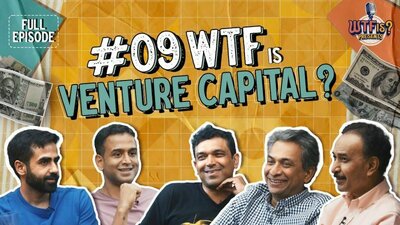PART III Epilogue
- Published
- Reading Time
- 6 minutes
A couple exchanging marriage vows are almost always thinking – “This is it! It’s for a lifetime!” Alas! It doesn’t work out sometimes. But the vows indicate that it was at least the hope. And many marriages, despite the odds, do last a lifetime. How often can one say that about a startup?
I think a startup we fund should aspire to have founders who outlast a fund life and a company that outlasts the founders! The company is the marriage that outlasts any single stakeholder.
The Listing Mindset
As we were preparing to launch our Fund II, I had written a piece “The Incremental Entrepreneur is not ours to chase”. (That piece is over 5 years old, just to give you perspective that this is not a new thought we’ve been harboring.) On the verge of the final closing of Blume Fund III (which is already 10 investments old), I’m making a case that is an extension of the same idea – it is not just about bringing a transformational market / product mindset to the startup’s birth, but really about how founders should never lose sight of accumulating partners – investors, team, customers – who will allow the founders to build a very large self-sustaining enterprise, one that can potentially outlast them.
All this is not to say that fund cycles will suddenly behave differently. If you end up having those 5-7 great exit outcomes in a cycle, more than half are still likely to be attractive large and mid-sized M&As! But that’s not the point. If a founder is not able to think at a scale where the org and the business looks like it is IPO-capable in a foreseeable end state, then why bother being (large-)VC-backed?
(The exceptions to this rule of building and/or managing scale will be incredibly novel IP-rich companies, which may get disproportionate value for their inventions, OR incredibly small and efficient teams that build a massively viral and scalable app/digital-only product that creates a new unique behavior or distribution that someone pays a handsome price for – gaming companies like Dream11, social / app giants like Waze, Musically, Instagram and Whatsapp are examples from this decade as are some AI, Biotech and Deep tech companies (Deep Mind, Climate) in the west that got gobbled up early by Google, Apple, et al)
We aren’t a large VC but we are feeders into them and so, pretty much have had to evolve to the rules that they play by (ergo, “The Incremental Entrepreneur is not ours to chase”). We have attempted to see what these outcomes would be like even for a small fund house (our Fund I was a 100cr fund and so, it was great to test this idea of a “listable” mindset at mini-scale).
Last year, one of the experiments was us helping one of our portfolio companies, E2E Networks, go for an SMB IPO on the NSE. It took the founders 2 years to be mentally prepared for the post IPO journey. Why were they doing it? Would they continue to adapt, build, grow and value create for themselves as founders and team members? They had to answer this for themselves.
They were profitable. 30% growth y-o-y for half a decade with almost no external cash infusion meant that we were at least eligible for a listing that got the company more capital than any private capital round was willing to provide. The business is still stabilizing and even though the stock has been punished for lack of growth in Year 1 post-listing, the team is unfazed and building away. We are hopeful it will be a 3x outcome from listing price in 3-4 years (which puts it in the 25-30% IRR range just from IPO date, its already close to a 10x prior to IPO, and we took a part exit too).
Fork in the road
We’ve noticed that founders reach this fork, where they realize that they’re on this path to long-term sustenance…OR NOT. It maybe the emotional toll, the opportunity cost, the lack of growth or any other lack of motivation that can derail and curtail the journey. But if they dig in, and if they choose the road less travelled, the best of them let all their stakeholders know the news. The company is here to stay! It may still get acquired, but rarely dies, and when it does get acquired, its in a state that can be managed well by professionals.
It’s been just 14 years since this first innings of Indian VC kicked off. It was a tough market till 2014-15 and with just a few scaled profitable businesses. Yet, the signs of these Founder Mentalities are there to witness. A few more examples from Blume’s Fund I (2011-14 vintage):
METTL – Seed in 2011, Series A 2012, No further rounds till exit to Mercer Consulting in 2018, great team build out, Head of Sales from SAP is now the CEO of the business, founders have both handed over their roles and exited within 2-3 quarters of acquisition.
EXOTEL – First round in 2012, never raised a rupee of debt or equity post, profitable all through, crossed 110cr ARR recently.
+ PRINTO | CCS | INSTAMOJO | GREYTIP | ZOPPER | ROUTEMATIC | WEBENGAGE | DATAWEAVE | TOOKITAKI | GREY ORANGE | PURPLLE, amongst others, who have that never-give-up attitude and keep growing.
Founders have rebooted cap tables, scrambled without any large VC rounds for 2-3 years or more, built to profitability, built teams much stronger than even the founding teams, or usually some combination of all this, while growing 3-10x in a 3-5 year phase. It’s incredible to watch. They eventually get rewarded, raise their large rounds and we think forerunners on that path such as Grey Orange and Purplle will get to an IPO sooner than later, from this list. The others too, we hope, will follow on similar paths.
With the right backers at the right time, these companies could’ve gone on to build 5-10x of their current / exited scale, if not more. We are looking for that mindset, earlier and earlier in the picking of great founders.
Interestingly, we are beginning to get inbounds from bourses: LSE (+AIM, the smaller London Market), Japan etc., apart from the Indian NSE and BSE waiting to help listings in any possible way. And, here’s the ultimate truth – there are 10x, if not 100x more participants in the public markets than private venture markets – we would do well to tap into the capital and wisdom of these markets, that have outlasted all companies and VCs.
Postscript story: Voice of Reason, Voice of Caution…
I would like to end with snippets from a recent set of email exchanges with an extremely thoughtful Fund I investor who set off the mail thread with an article around an M&A event in Industrial Robotics, suggesting that this buyer could also be a potential acquirer for one of our star portfolio cos – Grey Orange Robotics.
Karthik (KR)’s reply:
“Yeah. There are always a few Japanese, German and American options if we need to go down that path – let’s see how Grey Orange grows. They want to be an IPO++ co”
Investor:
“Tough road to IPO?
You should convince them to take a big check”
KR:
“Always a tough road to IPO 🙂
But hoping a few of my founders take that road
I’m tired of Int’l LPs thinking it can’t be done in VC-backed startups out of India”
Investor:
I don’t think international LPs say it can’t be done (at least I am not saying that). I am just saying it is a tough road. And the historical track record of VC backed startups in India succeeding in the public market is not great which adds to the concern.
As someone who watches and follows every single US IPO – I can tell you running a company in the private market with a couple of owners is very different than running a company under the scrutiny of the public market.
I’ve seen my fair share of companies spurn acquisition offers for the IPO path, only to watch their share price drop by 50% or worse and then the strategic acquiror suddenly disappear. Not saying it always happens or it will happen here.
And while the Blume franchise would definitely benefit from a rockstar IPO, I think the downside of a failed IPO/poor return on Fund 1 is much greater than the upside of a rockstar IPO vs. the sale of a unicorn which pays back the entire fund 1
Just my two cents from a risk/reward perspective for Blume …
In any case, if Grey Orange is going to be an IPO company and you think the US market is where it would list, I’m happy to talk to them one of these days. Ideally, you should start preparations for an IPO ~24 months in advance. I wouldn’t put a lot of weight in the bank equity capital market guys to give acceptable level of coaching/counseling.
KR:
Agree with you on most counts. However, I think these challenges persist even in M&A’s, even if one were to discover a similar sized acquisition instead of an IPO. If we were seeking a cash payout through an acquisition, the buyer will inevitably and eventually be prone to the same capital market risks and will apply similar valuation benchmarks as that of a listed company.
M&As tend to create an incredible number of exits in tech and are a critical engine for recycling of capital, talent, innovation from smaller innovative companies to larger ones but to assume that people will pay for an Indian company, without the fundamental tenets of what otherwise looks like either world class innovation or a world class public company (in terms of a path to profitability) is a naïve and short-term escapist view for the collective Indian VC market to take.



